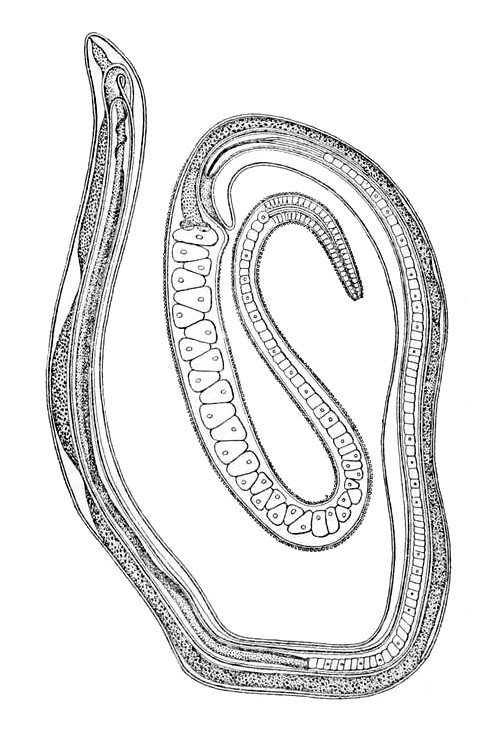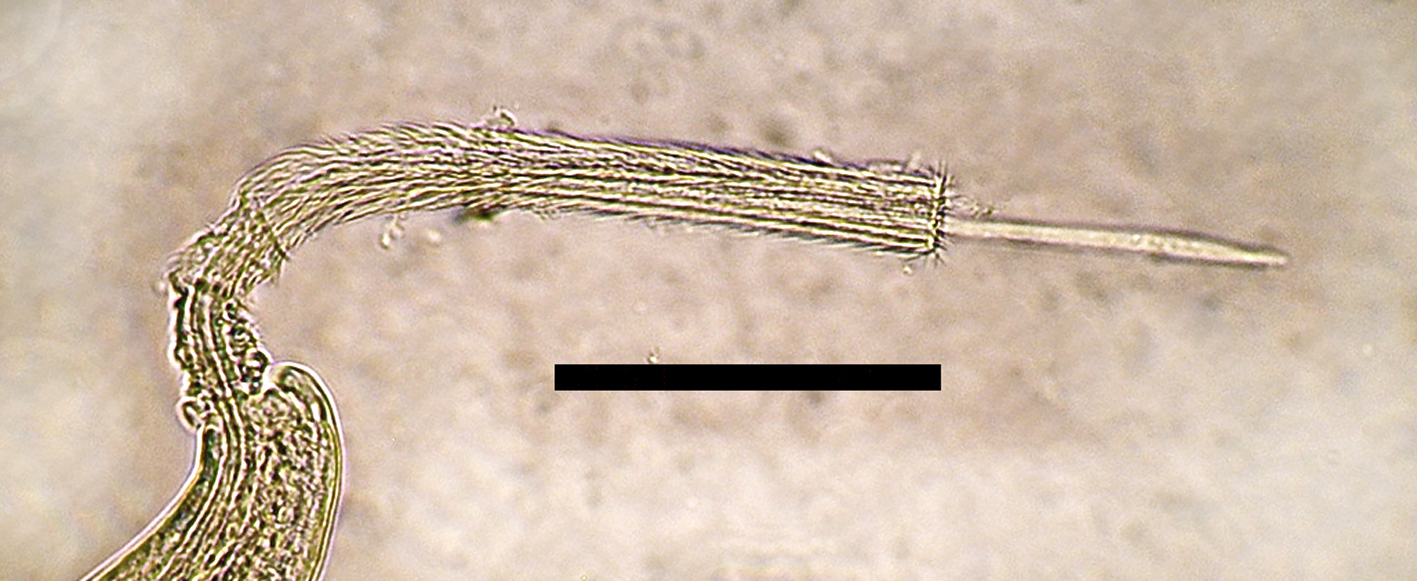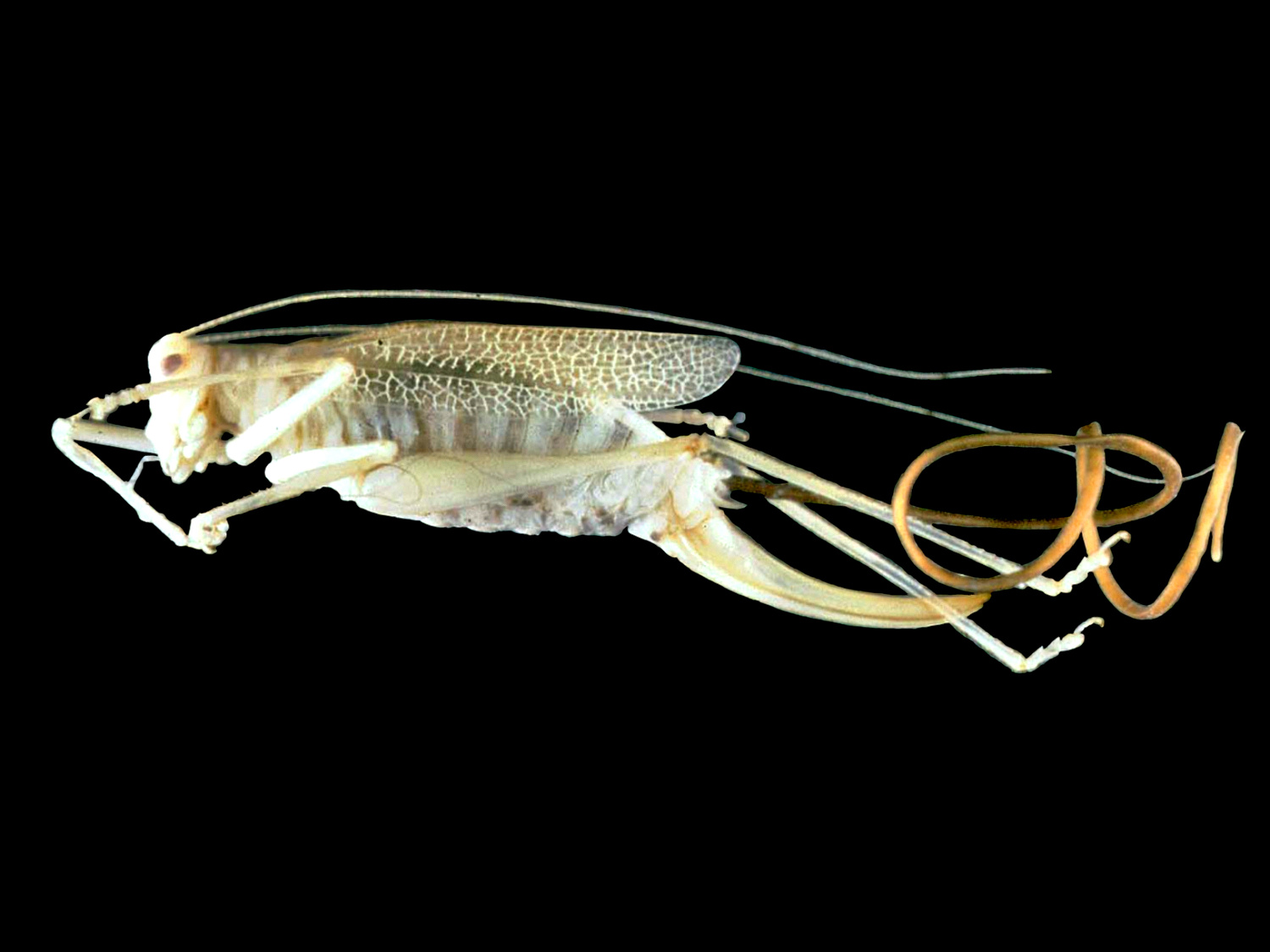|
Stichocyte
Stichocytes are glandular unicellular cells arranged in a row along the posterior portion of the oesophagus, each of which communicates by a single pore with the lumen of the oesophagus. They contain mitochondria, rough endoplasmic reticulum, abundant Golgi apparatuses, and usually 1 of 2 types of secretory granules, α-granules and β-granules, indicating secretory function.Chitwood, B. G. & Chitwood, M. B. (1950). Introduction to Nematology (Vol. 1). Baltimore: Monumental Printing Co. Collectively stichocytes form the stichosome. Characteristic of Trichocephalida and Mermithida, two groups of nematode The nematodes ( or ; ; ), roundworms or eelworms constitute the phylum Nematoda. Species in the phylum inhabit a broad range of environments. Most species are free-living, feeding on microorganisms, but many are parasitic. Parasitic worms (h ...s. References {{reflist, 30em Helminthology Nematode anatomy ... [...More Info...] [...Related Items...] OR: [Wikipedia] [Google] [Baidu] |
Stichosome
A stichosome (from Greek ''stichos (στίχος)'' = row; ''soma (σῶμα)'' = body) is a multicellular organ that is very prominent in some species of nematodes and consists of a longitudinal series of glandular unicellular cells (stichocytes) arranged in a row along the oesophagus that forms the posterior esophageal glands.Despommier DD, Müller M. The stichosome and its secretion granules in the mature muscle larva of ''Trichinella spiralis''. Journal of Parasitology, 1976 Oct;62(5):775-85. Individual stichocytes contain networks of intracellular canaliculi and open into the esophageal lumen by a narrow duct process, likely with secretory functions. Function as a storage organ has also been proposed. Notable taxa with stichosomes are families Mermithidae, Trichinellidae and Trichuridae within order Stichosomida and class Adenophorea, alternatively classified as the orders Trichinellida and Mermithida within subclass Dorylaimia and class Enoplea Enoplea (enopleans) ... [...More Info...] [...Related Items...] OR: [Wikipedia] [Google] [Baidu] |
Trichocephalida
The Trichocephalida (Trichinellida or Trichurida in other classifications) is an order of parasitic nematodes. Taxonomy The order Trichocephalida includes, according to modern classifications, the single suborder Trichinellina Hodda, 2007, which itself includes the single superfamily Trichinelloidea Ward, 1907, which itself includes 6 families: * Family Anatrichosomatidae Yamaguti, 1961 (1 genus, 5 species) including the single genus '' Anatrichosoma'' * Family Capillariidae Railliet, 1915 Railliet, A. 1915: L'emploi des médicaments dans le traitement des maladies causées par des Nématodes. ''Recueil de Médecine Vétérinaire, Paris,'' 91, 490–513. ot seen/ref> (1 subfamily, 18-22 genera according to classifications,Moravec, F. 2001: Trichinelloid Nematodes parasitic in cold-blooded vertebrates. Academia, Praha, 432 pp. (list of genera of Capillariidae in pages 30-32) () 390 species) including '' Capillaria'' * Family Cystoopsidae Skrjabin, 1923 (2 subfamilies, 2 gener ... [...More Info...] [...Related Items...] OR: [Wikipedia] [Google] [Baidu] |
Eucoleus Aerophilus Female Vulva
''Eucoleus'' is a genus of nematodes belonging to the family Capillariidae. Dwelling ''primarily in the airways of foxes, it can be found worldwide in dogs and cats''''.'' The genus has cosmopolitan distribution. Species: *''Eucoleus aerophilus'' *'' Eucoleus annulatus'' *'' Eucoleus bacillatus'' *'' Eucoleus baskakowi'' *'' Eucoleus boehemi'' *'' Eucoleus boehmi'' *'' Eucoleus contortus'' *''Eucoleus dispar'' *''Eucoleus dubius'' *''Eucoleus garfiai'' *''Eucoleus gastricus'' *''Eucoleus obtusiuscula'' *''Eucoleus oesophagicola'' *''Eucoleus perforans'' *''Eucoleus schvalovoj'' *''Eucoleus spiralis'' *''Eucoleus tenuis'' *''Eucoleus vanelli ''Eucoleus'' is a genus of nematodes belonging to the family Capillariidae. Dwelling ''primarily in the airways of foxes, it can be found worldwide in dogs and cats'.'' The genus has cosmopolitan distribution. Species: *''Eucoleus aerophi ...'' References {{Taxonbar, from=Q20680324 Enoplia Enoplea genera Par ... [...More Info...] [...Related Items...] OR: [Wikipedia] [Google] [Baidu] |
Oesophagus
The esophagus (American English), oesophagus (British English), or œsophagus ( archaic spelling) ( see spelling difference) all ; : ((o)e)(œ)sophagi or ((o)e)(œ)sophaguses), colloquially known also as the food pipe, food tube, or gullet, is an organ in vertebrates through which food passes, aided by peristaltic contractions, from the pharynx to the stomach. The esophagus is a fibromuscular tube, about long in adults, that travels behind the trachea and heart, passes through the diaphragm, and empties into the uppermost region of the stomach. During swallowing, the epiglottis tilts backwards to prevent food from going down the larynx and lungs. The word ''esophagus'' is from Ancient Greek οἰσοφάγος (oisophágos), from οἴσω (oísō), future form of φέρω (phérō, "I carry") + ἔφαγον (éphagon, "I ate"). The wall of the esophagus from the lumen outwards consists of mucosa, submucosa (connective tissue), layers of muscle fibers between lay ... [...More Info...] [...Related Items...] OR: [Wikipedia] [Google] [Baidu] |
Mitochondria
A mitochondrion () is an organelle found in the cells of most eukaryotes, such as animals, plants and fungi. Mitochondria have a double membrane structure and use aerobic respiration to generate adenosine triphosphate (ATP), which is used throughout the cell as a source of chemical energy. They were discovered by Albert von Kölliker in 1857 in the voluntary muscles of insects. The term ''mitochondrion'', meaning a thread-like granule, was coined by Carl Benda in 1898. The mitochondrion is popularly nicknamed the "powerhouse of the cell", a phrase popularized by Philip Siekevitz in a 1957 ''Scientific American'' article of the same name. Some cells in some multicellular organisms lack mitochondria (for example, mature mammalian red blood cells). The multicellular animal '' Henneguya salminicola'' is known to have retained mitochondrion-related organelles despite a complete loss of their mitochondrial genome. A large number of unicellular organisms, such as microspo ... [...More Info...] [...Related Items...] OR: [Wikipedia] [Google] [Baidu] |
Endoplasmic Reticulum
The endoplasmic reticulum (ER) is a part of a transportation system of the eukaryote, eukaryotic cell, and has many other important functions such as protein folding. The word endoplasmic means "within the cytoplasm", and reticulum is Latin for "little net". It is a type of organelle made up of two subunits – rough endoplasmic reticulum (RER), and smooth endoplasmic reticulum (SER). The endoplasmic reticulum is found in most eukaryotic cells and forms an interconnected network of flattened, membrane-enclosed sacs known as cisternae (in the RER), and tubular structures in the SER. The membranes of the ER are continuous with the outer nuclear membrane. The endoplasmic reticulum is not found in red blood cells, or spermatozoa. There are two types of ER that share many of the same proteins and engage in certain common activities such as the synthesis of certain lipids and cholesterol. Different types of Cell (biology), cells contain different ratios of the two types of ER dependin ... [...More Info...] [...Related Items...] OR: [Wikipedia] [Google] [Baidu] |
Golgi Apparatus
The Golgi apparatus (), also known as the Golgi complex, Golgi body, or simply the Golgi, is an organelle found in most eukaryotic Cell (biology), cells. Part of the endomembrane system in the cytoplasm, it protein targeting, packages proteins into membrane-bound Vesicle (biology and chemistry), vesicles inside the cell before the vesicles are sent to their destination. It resides at the intersection of the secretory, lysosomal, and Endocytosis, endocytic pathways. It is of particular importance in processing proteins for secretion, containing a set of glycosylation enzymes that attach various sugar monomers to proteins as the proteins move through the apparatus. The Golgi apparatus was identified in 1898 by the Italian biologist and pathologist Camillo Golgi. The organelle was later named after him in the 1910s. Discovery Because of its large size and distinctive structure, the Golgi apparatus was one of the first organelles to be discovered and observed in detail. It was d ... [...More Info...] [...Related Items...] OR: [Wikipedia] [Google] [Baidu] |
Mermithida
Mermithida is an order of nematode The nematodes ( or ; ; ), roundworms or eelworms constitute the phylum Nematoda. Species in the phylum inhabit a broad range of environments. Most species are free-living, feeding on microorganisms, but many are parasitic. Parasitic worms (h ... worms. The order includes two families, and most members are endoparasites on arthropods. One of the morphological characteristics of the order is the presence of a stichosome.Chitwood, B. G. & Chitwood, M. B. (1950). Introduction to Nematology (Vol. 1). Baltimore: Monumental Printing Co.Z. X. Chen, D. W. Dickson (eds.) (2004) Nematology: Nematode Management and Utilization. CABI Publishing. p. 847 References Enoplea Parasitic nematodes of animals Nematode orders Taxa named by Libbie Henrietta Hyman {{Enoplea-stub ... [...More Info...] [...Related Items...] OR: [Wikipedia] [Google] [Baidu] |
Nematode
The nematodes ( or ; ; ), roundworms or eelworms constitute the phylum Nematoda. Species in the phylum inhabit a broad range of environments. Most species are free-living, feeding on microorganisms, but many are parasitic. Parasitic worms (helminths) are the cause of soil-transmitted helminthiases. They are classified along with arthropods, tardigrades and other moulting animals in the clade Ecdysozoa. Unlike the flatworms, nematodes have a tubular digestive system, with openings at both ends. Like tardigrades, they have a reduced number of Hox genes, but their sister phylum Nematomorpha has kept the ancestral protostome Hox genotype, which shows that the reduction has occurred within the nematode phylum. Nematode species can be difficult to distinguish from one another. Consequently, estimates of the number of nematode species are uncertain. A 2013 survey of animal biodiversity suggested there are over 25,000. Estimates of the total number of extant species are su ... [...More Info...] [...Related Items...] OR: [Wikipedia] [Google] [Baidu] |
Helminthology
Helminthology is the study of parasitic worms (helminths). The field studies the taxonomy of helminths and their effects on their hosts. The origin of the first compound of the word is the Greek '' ἕλμινς'' - helmins, meaning "worm". In the 18th and early 19th century there was wave of publications on helminthology; this period has been described as the science's "Golden Era". During that period the authors Félix Dujardin, William Blaxland Benham, Peter Simon Pallas, Marcus Elieser Bloch, Otto Friedrich Müller, , Biodiversity Heritage Library Johann Goeze, Friedrich Zenker, Charles Wardell Stiles Charles Wardell Stiles (May 15, 1867 – January 24, 1941) was an American parasitology, parasitologist born in Spring Valley, New York. He was notable for working on a campaign against hookworm infestation in the American South, where it had bee ..., Carl Asmund Rudolphi, Otto Friedrich Bernhard von Linstow and Johann Gottfried Bremser started systematic scientific ... [...More Info...] [...Related Items...] OR: [Wikipedia] [Google] [Baidu] |








